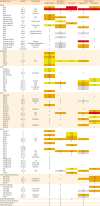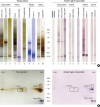1. Kim MA, Kim DK, Yang HJ, Yoo YY, Park HS, et al. Pollen-Food allergy syndrome in Korean pollinosis patients: a nationwide survey. Allergy Asthma Immunol Res. 2018.

2. Werfel T, Asero R, Ballmer-Weber BK, Beyer K, Enrique E, Knulst AC, et al. Position paper of the EAACI: food allergy due to immunological cross-reactions with common inhalant allergens. Allergy. 2015; 70:1079–1090.


3. Hugues B, Didierlaurent A, Charpin D. Cross-reactivity between cypress pollen and peach: a report of seven cases. Allergy. 2006; 61:1241–1243.


4. Sénéchal H, Šantrůček J, Melčová M, Svoboda P, Zídková J, Charpin D, et al. A new allergen family involved in pollen food-associated syndrome: Snakin/gibberellin-regulated proteins. J Allergy Clin Immunol. 2018; 141:411–414.e4.


5. Nahirñak V, Almasia NI, Hopp HE, Vazquez-Rovere C. Snakin/GASA proteins: involvement in hormone crosstalk and redox homeostasis. Plant Signal Behav. 2012; 7:1004–1008.


6. Kuddus MR, Rumi F, Tsutsumi M, Takahashi R, Yamano M, Kamiya M, et al. Expression, purification and characterization of the recombinant cysteine-rich antimicrobial peptide snakin-1 in
Pichia pastoris. Protein Expr Purif. 2016; 122:15–22.

7. Shahali Y, Sutra JP, Haddad I, Vinh J, Guilloux L, Peltre G, et al. Proteomics of cypress pollen allergens using double and triple one-dimensional electrophoresis. Electrophoresis. 2012; 33:462–469.


8. Shahali Y, Sutra JP, Hilger C, Swiontek K, Haddad I, Vinh J, et al. Identification of a polygalacturonase (Cup s 2) as the major CCD-bearing allergen in Cupressus sempervirens pollen. Allergy. 2017; 72:1806–1810.
9. Senechal H, Charpin D, Couderc R, Poncet P. Gibberellin-regulated proteins and the enigma of the “missing link”. Rev Fr Allergol. 2018; 58:63–67.
10. Tuppo L, Alessandri C, Pasquariello MS, Petriccione M, Giangrieco I, Tamburrini M, et al. Pomegranate cultivars: identification of the new IgE-binding protein pommaclein and analysis of antioxidant variability. J Agric Food Chem. 2017; 65:2702–2710.


11. Tuppo L, Alessandri C, Pomponi D, Picone D, Tamburrini M, Ferrara R, et al. Peamaclein--a new peach allergenic protein: similarities, differences and misleading features compared to Pru p 3. Clin Exp Allergy. 2013; 43:128–140.








 PDF
PDF ePub
ePub Citation
Citation Print
Print



 XML Download
XML Download